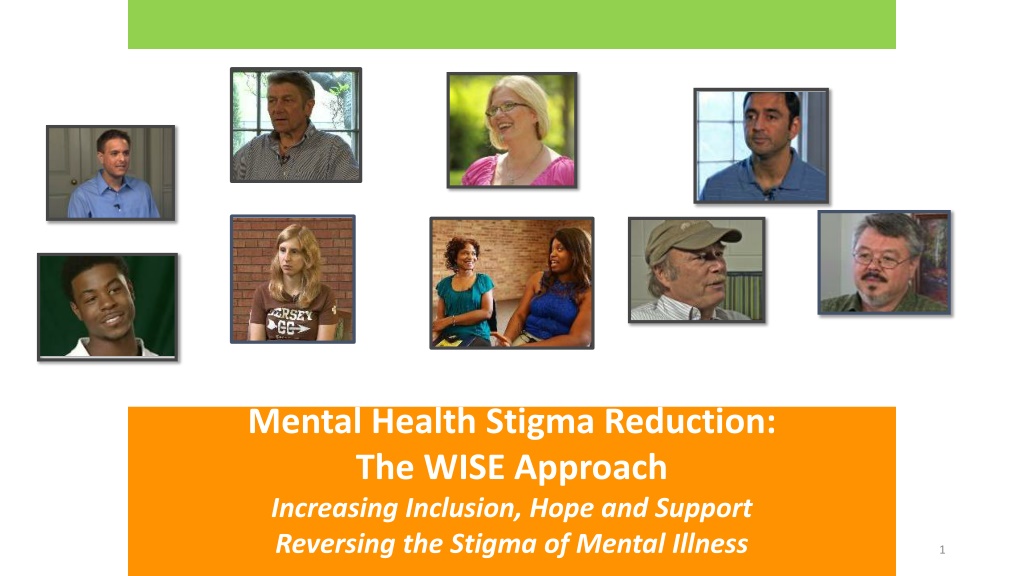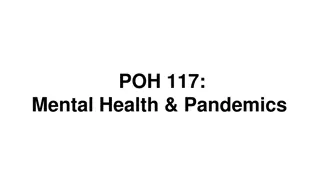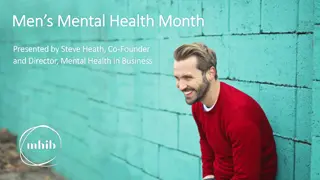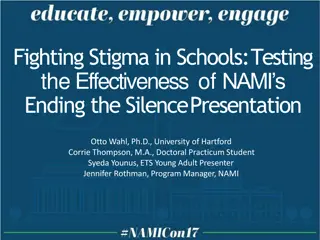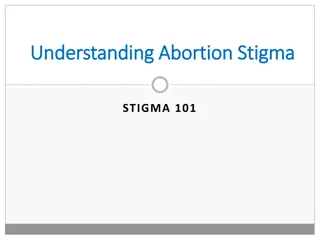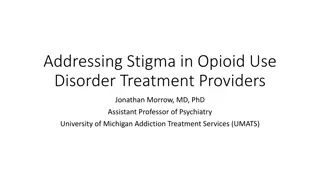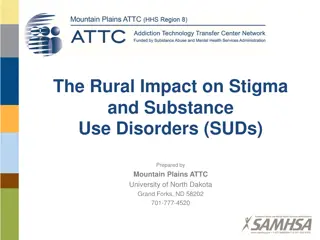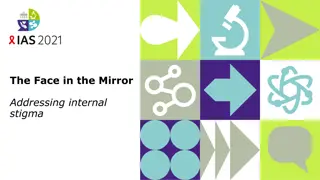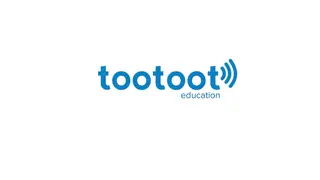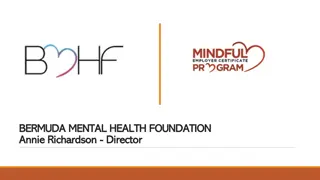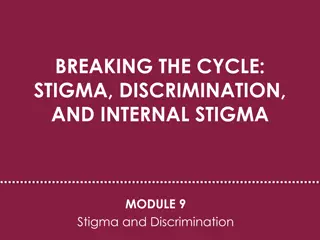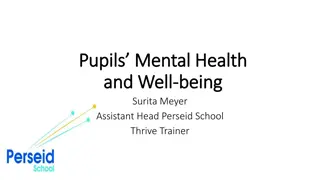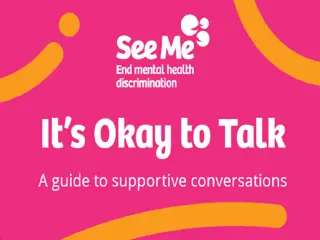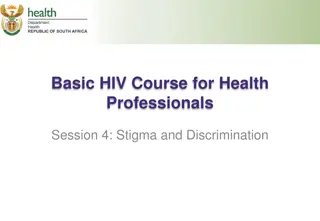Understanding and Combatting Mental Health Stigma
Explore the WISE approach to reducing mental health stigma by increasing inclusion, hope, and support. Learn about the types of stigma, stigmatizing ideas and actions, self-stigma, and the ongoing impact of stigma on individuals. Discover how education can play a crucial role in changing societal views and decreasing stigma.
Download Presentation

Please find below an Image/Link to download the presentation.
The content on the website is provided AS IS for your information and personal use only. It may not be sold, licensed, or shared on other websites without obtaining consent from the author. Download presentation by click this link. If you encounter any issues during the download, it is possible that the publisher has removed the file from their server.
E N D
Presentation Transcript
Mental Health Stigma Reduction: The WISE Approach Increasing Inclusion, Hope and Support Reversing the Stigma of Mental Illness 1
They are us! schizophrenia drug and alcohol use depression 1 in 4 trauma eating disorders 47% in our lifetime 2
Stigma Types Definition Internalized Stigma Stereotype-ideas Public Prejudice-beliefs Structural Discrimination-actions 3
Stigmatizing Ideas and Beliefs Sumi Stereotypes - Ideas People with mental health challenges are incapable, fragile, dangerous, cannot recover Charles Mark Val Linda and Nneka Prejudice - Beliefs They are less than. 4
Stigmatizing Actions Discrimination - Social I don t want them to live next door, be a co-worker, marry into my family Paul Discrimination - Structural Institutional, organizational, governmental limits to: -availability -accessibility -acceptability Pastor Tim Denise 5
Self and Public Stigma I am unable Efficacy I am not good Self Esteem Public Stigma Why try? Avoidance, Anger, Apathy 6
ALL OPPRESSION IS CONNECTED Sexism Racism Heterosexism Ableism Ageism Etc. 7
OK, but isn t it better lately? 8
The Ongoing Impact of Stigma Worse healthcare Lost employment Sub-par housing Diminished education opportunities Alienated from faith community 9
What Changes Stigma? Is education the best approach? Patrick Corrigan, PhD an international stigma researcher 10
Results from a Meta-analysis Does Stigma Decrease as Knowledge Increases? Knowledge: Causes of Mental Illness Stigma: Acceptance Source: Schomerus, Schwann, Holzinger, Corrigan, Grabe, Carta, & Angermeyer, 2011 11
Meta-analysis: Brain Disease as CAUSE 80 Sz 70 60 Dep 50 40 30 20 10 0 1990 1994 1998 2002 2006 12
Meta-analysis: ACCEPTANCE of neighbor 60 Sz Dep 50 40 30 20 10 0 1990 1994 1998 2002 2006 13
The Contact Approach I d like you to meet Mark, Simone, Rosa, Linda, Nneka, Charles, Paul, Val, Dori, Sumi, and Denise. Hear their stories on Eliminatestigma.org 14
Resilience and Recovery Resilience - the capacity of children and adults to succeed and thrive, despite experiencing trauma, mental illness and/or addiction. Recovery - A process of change through which people improve their health and wellbeing, live a self-directed life, and strive to achieve their full potential. Four dimensions of recovery (from SAMHSA): My Health A safe and supportive Home A sense of Purposein my life Belonging to Community 15
Contact vs Education: AVOIDANCE pre post 3 2 1 0 -1 -2 -3 -4 control group education: dangerousness education: responsibility contact: dangerousness contact: responsibility Source: Corrigan et al., 2002 16
Education vs Contact over time pre follow-up 3 2 1 0 -1 -2 -3 -4 control group education: dangerousness education: responsibility contact: dangerousness contact: responsibility 17
Goal? CAREFULLY create environments where all can speak up TLC4 stigma reduction Up to Me (a HOP program) strategic disclosure Safe Person - Seven Promises supportive listening Compassion Resilience caregivers and providers 18
TLC4 Targeted Local Credible Continuous Change-focused Contact 19
Who Should the TARGETS Be? community, healthcare, government home, work, school individual 20
What is LOCAL Contact? Does it play in your environment? 21
What is CREDIBLE Contact? Contact with peer Example- Nurse to nurse Pastor to pastor Athlete to Athlete 22
CONTINUOUS Contact Once is not enough And variety is needed 23
CHANGE-FOCUSED Contact What do you want the target group to do differently as a result of the contact? 24
TLC4 Targeted to particular groups or settings where people have encountered stigma Local culture should drive program adaptations Contact with people who live it! Credible contact with someone who is similar to us Change-focused determine what you want the targeted group to do differently Continuous contact with a variety of people over time establishes a wide base for the shift 25
Reversing Self and Public Stigma Inclusion and Self Directed Support I am good Self Esteem I am able Efficacy Public Stigma I care for myself and others Motivated Engagement 26
What YOU Can Do Today 1. Maintain recovery perspective on a daily basis- proactively seek out stories. 2. Reinforce and support resilience and recovery in others. 3. Create curiosity - be prepared to speak up. 4. Consider the story you can tell about recovery 5. Bring the conversation to your community work, civic, faith, schools. 27
The WISE Approach To reach our shared goal of increasing inclusion and support, learn about the other three prongs of the WISE approach at EliminateStigma.org. TLC4 stigma reduction Up to Me (a HOP program) strategic disclosure Safe Person - Seven Promises supportive listening Compassion Resilience caregivers and providers 28
Thanks for the work you do! To request resources and/or facilitator training, email: wise@eliminatestigma.org Website: www.eliminatestigma.org 29
